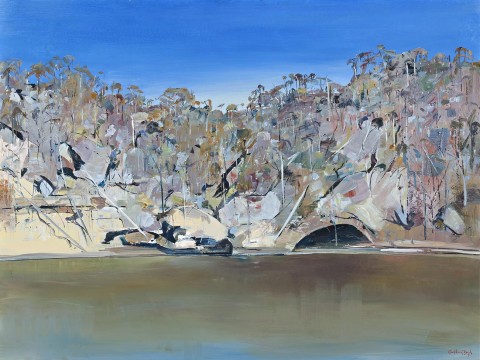SHOALHAVEN
ARTHUR BOYD
oil on composition board
91.5 x 122.5 cm
signed lower right: Arthur Boyd
Lister Gallery, Perth, acquired directly from the artist
Private collection, Perth
Arthur Boyd returned to Australia in 1971, eager to rediscover his antipodean roots having spent over a decade in the lush English countryside. A short time after his homecoming, art dealer Frank McDonald invited Arthur and his wife Yvonne to visit his property by the banks of the Shoalhaven River, on the south coast of New South Wales. On this sweltering hot day Boyd commenced a sketch of the Shoalhaven River, thus beginning a love affair with the region and its many moods. Boyd and his wife proceeded to purchase two properties adjacent to the Shoalhaven River, ‘Riversdale’ and later ‘Bundanon’, the wild landscape becoming one of Boyd’s most enduring subjects, painted well into his final years.
The majesty of the soaring cliffs which border the Shoalhaven remained a perennial image of the series, with the sunbathed Nowra sandstone standing timelessly above the tranquil river. As Janet McKenzie has observed; 'The natural beauty of the Shoalhaven area caused Boyd to marvel constantly. His paintings are a celebration of the grandeur and wonder of Nature. It is to Boyd's credit that a single landscape can inspire such diversity of work. He gives us the impression that in life there are infinite possibilities, as long as we train ourselves to see’.1
Devoid of the boats, figures and swans often featured in the series, Shoalhaven is a pure landscape, celebrating the unspoiled bush, completely removed from urban life. The piercing blue of the sky above the still waters of the river, creates a scene that ‘glow[s] with well-being, joy and a sense of youth’.2 Shoalhaven is removed from the religious and lyrical connotations imbued in a number of paintings of this subject, instead portraying a truly enchanting summer day, with ‘air so clear and hot that light carved out the shapes of rocks like a burning scalpel.’3 Shoalhaven bears a remarkable likeness to Tom Roberts’ In a corner on the Macintyre, 1895 (National Gallery of Australia, Canberra). Both paintings, local of scene, yet national in imagery, are unquestionably Australian in colour, light and atmosphere. Sandra McGrath describes this influence more broadly:
While Boyd in general chooses to portray the Shoalhaven landscape more identified with Von Guerard and Buvelot, at other times he cannot resist the temptation to paint the landscape in the manner of the early Box Hill painters ... Despite their reliance on a realistic approach to the subject, the Boyd Shoalhaven landscapes are more varied in technique and style than one might suppose. With his prodigious ability the artist is able to take the nature of the subject and render it in a manner which captures the essence of its particular properties at that time, or imbue it with a sense of character and meaning which is the result of his own immediate emotional or psychological response.4
Having always delighted in his painting trips along the river, Boyd believed his magical Bundanon property should belong to the Australian people. Soon after Shoalhaven was painted, the property was gifted to the Australian Government, to be preserved forever, in the hope that future generations may also be inspired by the beauty and brilliance of the Shoalhaven River.
1. McKenzie, J., Arthur Boyd at Bundanon, Academy Press, London, 1994, p. 42
2. McGrath, S., The Artist and the River: Arthur Boyd and the Shoalhaven, Bay Books, Sydney, 1982, p. 62
3. ibid.
4. McGrath, S., The Artist and The River: Arthur Boyd and The Shoalhaven, Bay Books, Sydney, 1982, p. 63
MELISSA HELLARD
